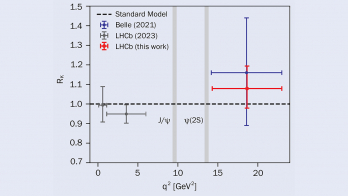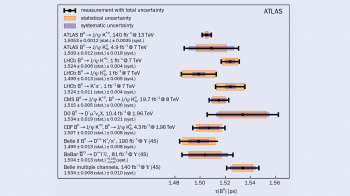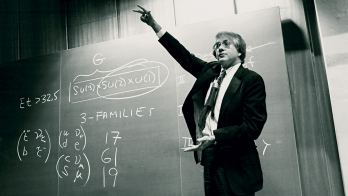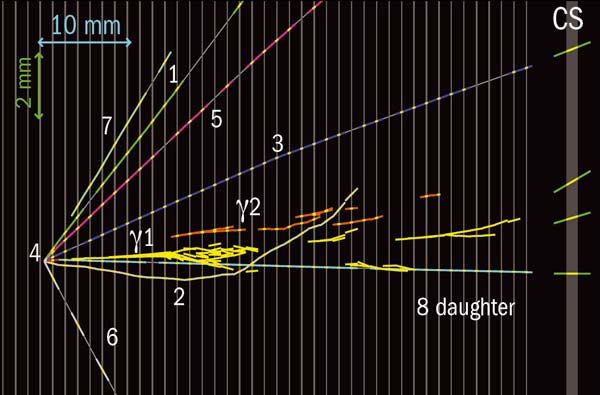
The OPERA collaboration has announced the observation of the first candidate tau-neutrino (ντ) in the muon-neutrino (νμ) beam sent through the Earth from CERN to the INFN’s Gran Sasso Laboratory 730 km away. The result is an important final piece in a puzzle that has challenged science for almost half a century.
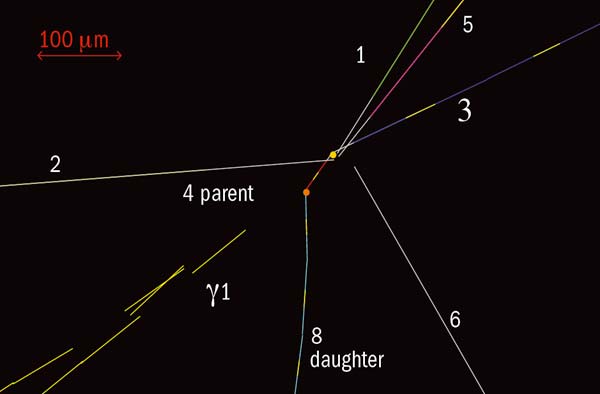
The puzzle surrounding neutrinos originated in the 1960s when the pioneering experiment by Ray Davis detected fewer neutrinos arriving at the Earth from the Sun than solar models predicted. A possible solution, proposed in 1969 by Bruno Pontecorvo and Vladimir Gribov, was that oscillatory changes between different types of neutrinos could be responsible for the apparent neutrino deficit. Conclusive evidence that electron-neutrinos, νe, from the Sun change type en route to the Earth came from the Sudbury Neutrino Observatory in 2002, a few years after the Super-Kamiokande experiment found the first evidence for oscillations in νμ created by cosmic rays in the atmosphere. Accelerator-based experiments have since observed the disappearance of νμ, confirming the oscillation hypothesis, but until now there have been no observations of the appearance of a ντ in a νμ beam.
OPERA’s result follows seven years of preparation and more than three years of beam provided by CERN. The neutrinos are generated at CERN when a proton beam from the Super Proton Synchrotron strikes a target, producing pions and kaons. These quickly decay, giving rise mainly to νμ that pass unhindered through the Earth’s crust towards Gran Sasso. The appearance and subsequent decay of a τ in the OPERA experiment would provide the telltale sign of νμ to ντ oscillation through a charged-current interaction.
Detecting the τ decay is a challenging task, demanding particle tracking at micrometre resolution to reconstruct the topology: either a kink – a sharp change (>20 mrad) in direction occurring after about 1 mm – as the original τ decays into a charged particle together with one or more neutrinos, or the vertex for the decay mode into three charged particles plus a neutrino.
The OPERA apparatus has two identical Super Modules, each containing a target section and a large-aperture muon spectrometer. The target consists of alternate walls of lead/emulsion bricks – 150,000 bricks in total – and modules of scintillator strips for the target tracker. The nuclear-emulsion technique allows the collaboration to measure the neutrino-interaction vertices with high precision. The scintillators provide an electronic trigger for neutrino interactions, localize the particular brick in which the neutrino has interacted, and perform a first tracking of muons within the target. The relevant bricks are then extracted from the walls so that the film can be developed and scanned using computer-controlled scanning microscopes.
The collaboration has identified the first candidate ντ in a sample of events from data taken in 2008–2009, corresponding to 1.89 × 1019 protons on the target at CERN. The sample contains 1088 events, including 901 that appear to be charged-current interactions. The search through these has yielded one candidate with the characteristics expected for the decay of a τ– into a charged hadron (h–), neutral pions (π0) and a ντ. Indeed, the kinematical analysis suggests the decay τ– → r–ντ. The event has a significance of 2.36 σ of not being a background fluctuation for the τ– decay to h–(π0)ντ.
This candidate event is an important first step towards the observation of ντ → νμ oscillations through the direct appearance of the ντ. That claim will require the detection of a few more events, but so far the collaboration has analysed only 35% of the data taken in 2008 and 2009 and ultimately should have five times as much data than as at present.



